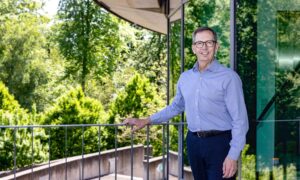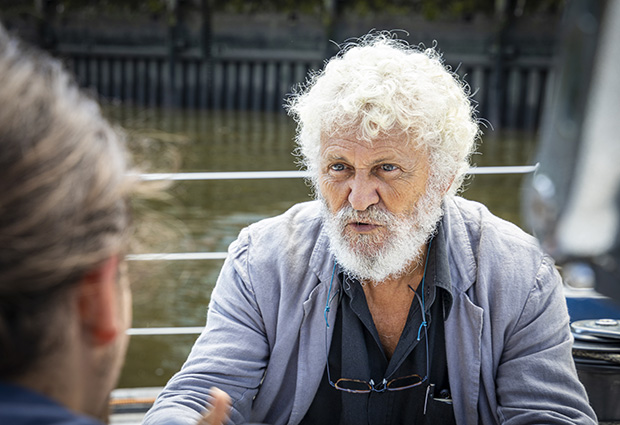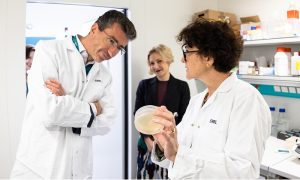
We all come from the ocean
Eric Karsenti’s dream of combining his loves of biology and sailing set in motion the Tara Oceans expedition

The camera team wanders around the quay, looking for the right angles to capture the boat. In the meantime, two French school classes are receiving a guided tour with scientific demonstrations. The French ambassador and consul appear, escorted by five bodyguards, and an elderly sailboat enthusiast walks by and insists to be let on board to greet the captain. Shortly afterwards, a rubber dinghy enters the harbour, bringing back some of the Tara crew who set out earlier to take samples from the river Elbe. It is a sunny morning in June and the Tara schooner is docked at the Sandtorhafen: Hamburg’s historic harbour. It is one of the first stopovers of Tara’s current expedition.
Amid all the movement, EMBL scientist Eric Karsenti appears at the quay and is immediately drawn on board. He is greeted with hugs and les bises by the crew. After a few minutes he vanishes below deck to take a look at the boat – the one that took him on the expedition he dreamed of for so long. Later in the morning, he finds a quiet corner to sit and talk to me about his connections with science, the ocean and the origins of the Tara Oceans expedition.
The call to adventure
“For part of my childhood I was raised close to the sea, by the English Channel. I have always been attracted to it,” says Karsenti. “I think the ocean represents a kind of dream for everyone, a dream of the time of expeditions, of exploring the world. When you’re sailing on it, you live differently. Time disappears. It’s like being in the desert, but at the same time it’s so full of life that you cannot see. It’s a special feeling. And, in the end, we all come from the ocean. It’s where life started and where life became complex.”
Karsenti started sailing at the age of twelve. “Then I got the bug and I have never stopped since,” he says, laughing. At eighteen, he went to a sailing school and then became a sailing teacher in Brittany, France. He pursued this career for ten years, while studying and earning his PhD. He then stopped sailing professionally to focus on his scientific career. Soon, the bug would call him back to the sea.
While he was the head of EMBL’s Cell Biology and Biophysics Unit, Karsenti read Darwin’s book The Voyage of the Beagle, and was fascinated by the story it told. “It’s a mixture of adventure and science. It was kind of magic. And, because I sail myself, I could imagine very well what Darwin went through. I thought it would be great to do a modern expedition. The dream was to have a sailing boat going around the world and talking about life, evolution, cell biology and what we’re doing at EMBL.” Karsenti wanted to popularise the life sciences using a sailing expedition with extensive media coverage. However, there were some obstacles in the way.
“We had no boat, no money, no TV producer,” Karsenti says, with a grin. “After some time I thought: ‘Well, the only way to make this work is to do a proper scientific expedition.’ So I started to talk to friends, like Christian Sardet.”
Karsenti and Sardet – now Emeritus Research Director at the Observatoire Océanologique de Villefranche-sur-Mer – came up with the idea of starting an expedition focusing on plankton biodiversity. Another friend of Karsenti’s, French sailor and single-handed racer Michel Desjoyeaux, knew the crew of a boat called Tara, which at the time was on an expedition drifting in the Arctic ice. A manager working with Desjoyeaux, Didier Velayoudon, put Karsenti in contact with Romain Troublé and Étienne Bourgois, who were running Tara. “And that’s how the whole thing started,” says Karsenti.

Shaping a common goal
Karsenti realised that his goals and the goals of the Tara crew were very complementary. Tara was lacking long-term commitment from the scientific community. “So, when we started to work together, to develop a strong programme, this went very well: we all wanted something very similar,” says Karsenti.
Although they now had a boat, Karsenti’s dream still faced various challenges before it could become a reality. The first was to develop a scientific project that would be suited to Tara’s size. “Nobody had really worked from a scientific point of view on the global ecosystem, which is what we wanted to do,” says Karsenti. This took about two years to put together. “We had meetings every three months to discuss how to take samples, how to analyse a sample and how to generate models.”
Karsenti explains that the key to success while designing the scientific project was the collective effort. This led to another challenge. “The second challenge was to get all the different scientists to understand that they should really work together, not for themselves but for a common goal, and that they would get more out of it if they worked together than if they worked individually on a small topic. You need a huge collaboration because there are so many different kinds of knowledge needed. That’s what CERN did for physics, and I think the power of EMBL is to do the same thing for biology.”
The third challenge was working with the media. “The Tara crew were extremely good at getting journalists. But we had to tell the media that things would work, even though we weren’t sure at all that they would. That was very difficult for me, because as a scientist I was not trained to do this. That is against our culture.”
The fourth and final challenge was to raise the money for the expedition. Together with Troublé and the other scientists, this took Karsenti three years of very hard work.
A more than accomplished dream
Finally, the Tara Oceans expedition became reality, followed by Tara Méditerranée,the Tara Pacific expedition, and now Mission Microplastics. Looking back, Karsenti considers his dream more than accomplished. “We did so much more than I thought we would do. I think this is now a very important project for the whole of humanity, because for the first time it may allow us to understand ocean ecosystems. I’m very happy. I’ve started to withdraw a little from the whole thing because I’m not so young any more. And it seems to be working extremely well without me. So that is even nicer, because it means I did a good job.”
Karsenti will keep in touch with Tara, and will continue to work on conceptual parts of the project, especially in coordinating the efforts of the institutions involved. However, he doesn’t want to be active in the day-to-day running of the project any more, as he wants to spend more time with his family. Once again, he shows a knack for combining the most important things in his life: he plans to take them sailing.


